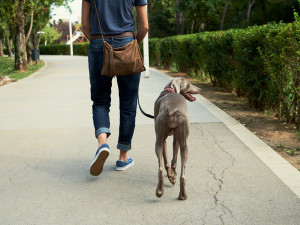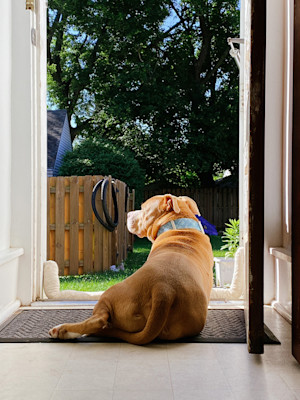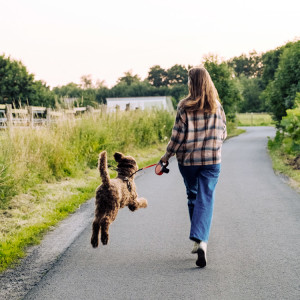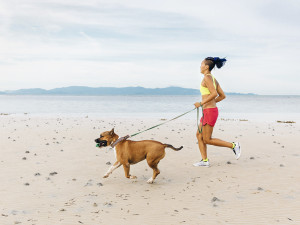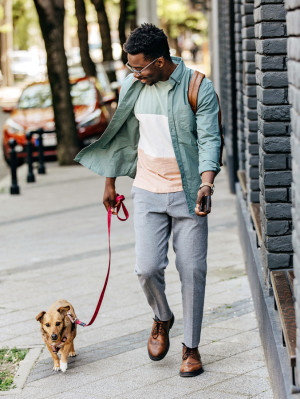The Internet’s Divided: Should You Wear Headphones When Walking Your Dog?
How to make sure you’re not missing any cues and that you both stay safe
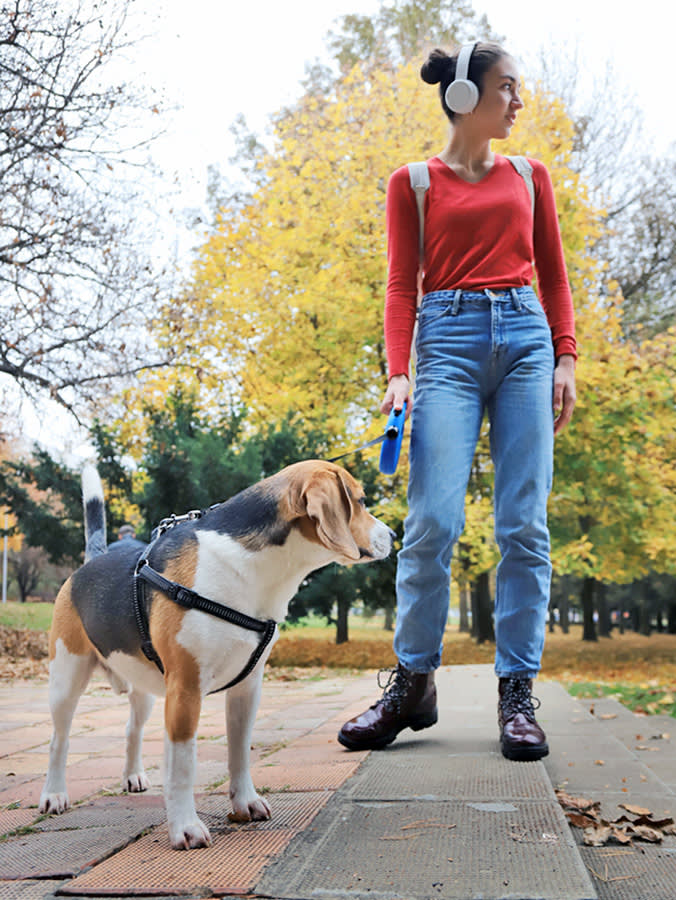
Share Article
I never imagined wearing headphones while walking my dog would prove controversial until I moved to a new area in the summer. I discovered I was one of the few in our local park who chose to do so, and other people seemed... a bit miffed?
I heard people say things like, “That poor dog, the owner isn’t paying attention to it,” or “How irresponsible!” while motioning to their ears as I strolled past. How do I know what they said? Because the majority of the time, I am not listening to anything. The headphones are to stop humans from interacting with me, not my dog. This may sound incredibly antisocial, but I am autistic, and small talk is scarier to me than a trip to the dentist.

Get (totally free) deals for food, treats, accessories, tech and way more pet parenting must-haves.
I never listen to anything while my dog Bonnie is off the lead, and I always make sure I can hear car engines, animals and other people while she is on the lead. I am super sensitive to noise, and as a woman who has lived in the world for over 40 years, I have a heightened awareness of my surroundings. Oblivious, I am not.
As a single dog parent who works from home, 90 percent of my daily conversations are one-sided chats with Bonnie. I am also the only person who walks my dog (in two years, that equates to over 2,000 trips outside), and sometimes, I do need the added incentive of a voicenote or a snippet of my favourite podcast. Bonnie and I check in with each other regularly. She can stop and sniff as much as she’d like, and I chat and play with her, all while wearing my headphones or earbuds.
I asked friends whether they wear headphones on a dog walk. The majority said yes, which made me feel a little better. But does this make us irresponsible dog parents? We asked dog behaviourist Jo Sellers from Pippin Pets Dog Trainingopens in new tab to discuss the potential risks of wearing headphones on a dog walk and how to ensure you connect with your dog while out and about.
The risks of wearing headphones on a dog walk
Jo Sellers knows that long walks can sometimes feel monotonous and understands why listening to audiobooks, podcasts or music can help pass the time. But she also worries about dog parents being distracted, which can be dangerous for both you and your pup.
As Jo explains, “The key risks include not being aware of who is around you or who is approaching. If your brain is only half listening, your reactions can be slower, so it may take more time to realise that there is a problem, such as your dog bothering other dogs or escalating tension with other dogs.”
She adds that when you’re zoned out, you may not notice when your dog wants you to slow down so they can stop and sniff, and you may not be fully in tune with your dog’s body language.
Jo says that if there is an issue with another dog, wearing headphones may open you up to more serious consequences, “Not all dogs love other dogs. The last thing they need is strangers running up and invading their personal space, which can lead to tension or fights. If your dog is perceived as out of control because [you are] distracted, it could leave you liable to legal action.”
Of course, there is also the risk of traffic – especially if you live in an urban area. Studies have shown that pedestrian-vehicle crashes are more likely to occur when the pedestrian is wearing headphonesopens in new tab. This is even more important to consider now that we have way more quieter electric vehicles – cars, bikes and scooters – on the roads. If you do decide to wear headphones while walking your dog then it is therefore crucial that either muting, or removing your headphones altogether becomes part of your built-in crossing-or-walking-near-the-road safety behaviour with your dog.
There are several other ways to lessen the risks of wearing headphones while walking your dog:
Only using one earbud allows audio to be listened to while allowing other sounds, including traffic, other animals, walkers and cyclists, to be heard.
Turn off the noise-cancelling option.
Invest in bone conductionopens in new tab headphones, which don’t go in your ears like earbuds or sit on top of your ears. These can help keep you aware of your surroundings.
Try not to wear headphones if your walk happens in the early morning or at night, when low light conditions can impede your vision, adding another potential hazard.
The benefits of walking with headphones on
No one suggests completely blocking outside noise when walking your dog, but for many humans, some background music can improve mood and motivation. As much as we love our dogs, there comes a point in the year when the grey days blend into one another, and you may need something to help lift your mood, especially if you struggle with mental health issues.
If a bit of background audio motivates you to take longer walks, the increased exercise may also benefit you and your dog. If you are prone to anxiety and use music or podcasts to calm you, this could also mean your dog isn’t picking up on your stress, which can affect them, too.
How to make sure you’re still connecting with your dog while wearing headphones
Being present and able to engage with your dog on their walk is crucial, according to Jo. “The dog walk could be the highlight of their day and an opportunity to show off their natural dog behaviours. Some dogs find walks overwhelming, and parents need to be alert to this so they can change direction or help their dogs in these spots. They do better if you are more observant of their communication and can engage fully.”
Jo suggests breaking up the walk by practising training and testing recall with environmental distractions to help increase your bond with your dog. “Dogs thrive on social interaction, so stop and see where they are sniffing, talk to them, or play games with them. I throw a treat and get my dog to find it or hide it in tree bark for her to sniff out.”
Learn the subtle body language signs that dogs use to communicate, have verbal cues to keep your dog in sight at any given time, and be able to call your dog back promptly. Remember, your dog showing you they are anxious may not look exactly as you assume.
Some lesser-known signs your dog is feeling worriedopens in new tab include:
Slowing down: this may indicate that they are unsure and trying to understand better what they’re up against. Their body might get tense, their ears may move back, tail lower or tongue flick out as they assess.
Leaning away: this literal rejection of whatever is concerning them might come along with yawning, narrowed eyes and lip licking.
Crouching down: shifting their body weight backwards with a tucked tail, a tense, closed mouth and furrowed brow could all be signs that your dog is trying to make themselves look as insignificant as possible to the perceived threat.
Lifting a paw: stopping and raising a paw can show apprehension.
Approaching with a lowered body: this could mean your dog wants to investigate but they’re apprehensive.
Performing an ‘appeasement grin�’: not to be mistaken for an aggressive display of teeth, this facial expression is meant to be submissive. The edges of the mouth are pulled up in a ‘smile’, eyes are squinted and ears are held back.
Other, more common signs that your dog is feeling anxious include:
excessive barking and howlingopens in new tab
excessive whining
Aggression
panting or drooling excessively
digging or scratching repetitively
pacing or restlessness
trembling or shaking
As Jo says, “Situations can change in an instant, so you need to be vigilant for the whole walk. This applies to your dog and dogs approaching you, so you can ensure that all interactions are wanted and safe.”
So, what‘s the verdict on headphones? If you’re wearing them, wear responsibly. Your number one focus on a dog walk is your pup, so just make sure you‘re confident that your headphones aren't stopping you from understanding your dog’s needs or being vigilant to their safety.
Just make sure to turn Espresso down when you near a road.

Catherine Renton
Catherine Renton is a writer based in Edinburgh whose work has been featured in Vogue, Elle, Glamour, Refinery29, and the Guardian, among others. When she's not writing, she is tending to the every whim of her cocker spaniel Bonnie, who loves belly rubs, people and chasing squirrels.
Related articles
![dog bouncing on lead in the countryside with girl]()
How to Make On-Lead Dog Walks More Exciting
There are plenty of ways to spice them up
![Dog lying on a brick street with a leash]()
“Why Won’t My Dog Walk Outside?”
Dog behaviourist Karen B London’s top tips to help get your parked pet moving
![Dachshund dog freezing on a rock during a walk]()
Why Does My Dog Turn Into a Statue on Walks?
Suddenly, the pavement has some new installation art: your frozen dog
![a black and white dog on lead sits in a misty graveyard]()
Should You Walk Your Dog In a Cemetery?
People are questioning not just if you’re allowed to walk your dog in a graveyard, but whether you should
![A woman wearing colorful activewear running on the beach with her dog.]()
Dogs Make Great Exercise Partners
Helpful tips on staying in shape with your dog
![Man walking his dog on a pavement]()
Does It Matter Where I Walk My Dog?
We delve into the age-old debate
